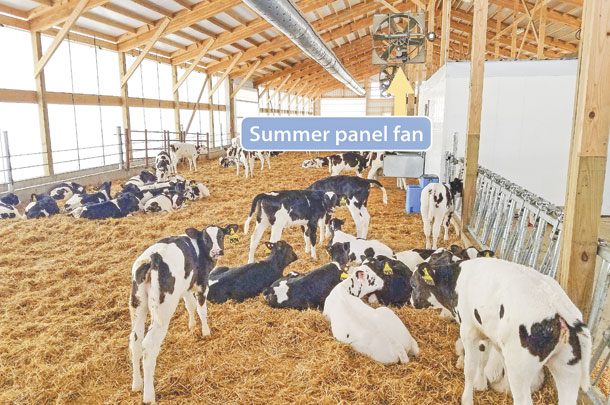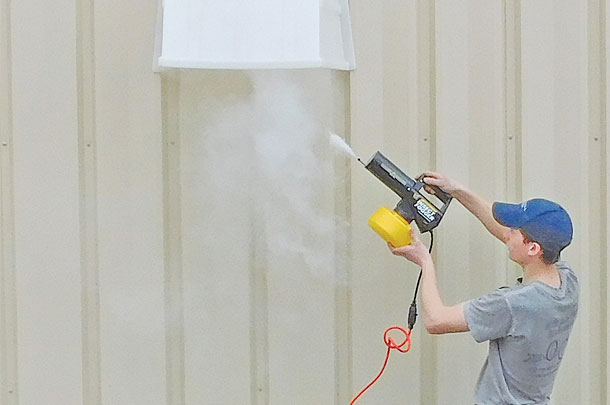Heat stress is a major concern for calves. Research has proven calves suffer from heat stress in much the same way cows do. A calf’s temperature threshold can be easily reached during summer months.
A daily temperature exceeding 77ºF can prevent calves from dissipating accumulated heat and result in performance declines.
Calves born during summer months have been shown to have lower average daily gains, reduced feed intake, increased maintenance energy needs and reduced immune function. These factors can result in poor growth and higher susceptibility to disease.
Providing proper nutrition, ample shade and access to fresh water are all important factors in combating heat stress. However, one common tactic deserving more attention is calf housing ventilation.
Crank up the fans
Increasing ventilation rates is one of the most effective ways to reduce heat stress among calves. Air speeds from 2 to 5 mph have been shown to have a cooling effect and are beneficial to calf health and performance during times of heat stress. High-speed cooling air offers the additional benefits of reduced fly pressure and drier bedding.
It is crucial to match the appropriate ventilation system to your calf housing style. Calf raisers using bedded packs and group housing can successfully ventilate their calf spaces with a combination of positive-pressure tubes, panel fans and curtain sidewalls.
This is because the large open spaces of bedded packs generally lack air flow obstructions, allowing the cooling air from panel fans and natural summer breezes to easily reach calves. In the summer, open curtain sidewalls and panel fans turned on high provide large volumes of high-speed air to help keep calves cool.

Panel fans and natural ventilation do not work well in providing cooling summer air flow to calves in individual pens. This is because the solid panels between calves often act as significant air flow obstructions and limit the amount of air reaching the calf.
All too often, as summer air flow from panel fans or natural ventilation moves toward the pens, it deflects off the solid panels and is prevented from reaching calves.
The best way to prevent heat stress in calves housed in individual pens is to center positive-pressure tubes, designed specifically for summer heat abatement, directly over the pens. This allows large volumes of fast air to be discharged straight down into the pen without being blocked by the solid panels between calves.
The dairy in the photo at the top of the article uses individual pens coupled with a multi-season positive-pressure tube centered over each row. Multi-season tubes can be adjusted to increase or decrease the air flow delivered to calves based on the season.
This multi-season tube is set for fast summer air flow, and all of the air is being discharged out large holes in the bottom of the tube, directly into the calf pens. Fog has been introduced to help visualize the air flow. Each calf pen is 4 feet wide, 4 feet tall and 7 feet long, or 112 cubic feet.
This particular multi-season tube is designed to discharge 148 cubic feet of air per minute to each calf at a speed of 5 mph during the summer. As a result, each calf receives a new pen full of fresh air (112 cubic feet) every 45 seconds, resulting in 79 pen volume changes every hour. This high volume and speed of air greatly benefits calves during hot weather by providing cooling air flow while keeping bedding dry and reducing fly stress. Summer ventilation tubes can also achieve these results.
See it for yourself
Trained ventilation experts can help evaluate the effectiveness of your calf barn ventilation system. These experts use air speed and volumetric flow meters, fogging devices and design software that aids in evaluating system performance.
That said, you do not have to be a ventilation expert to get an idea of how your ventilation system is performing. For instance, you can watch the air flow in your calf barn by fogging. Fogging devices enable you to visualize where the air is moving – or is not moving, in the case of dead spots.

Fogging also provides an approximation as to the number of air exchanges per hour.
To evaluate your ventilation system:
1. Use a fogging device as shown in the bottom photo on this page. The fog will be sucked into the fan and discharged toward calves, allowing you to see air flow in the barn. The fog generated will not harm the calves.
Once an area is filled with fog, time how long it takes to clear out. Use that time to calculate the number of air exchanges your system is providing. Take the number 60 and divide it by the time, in minutes, it took for the area to clear.
For example, if it takes six minutes for the fog to clear (60 / 6 = 10), the system is providing approximately 10 air exchanges per hour. Current industry guidelines suggest barns receive 40 air exchanges per hour in the summer.
However, this recommendation looks at ventilation on an entire barn level rather than at the calf level. When watching how the fog clears the barn, pay close attention to how the pens clear the fog to understand what is happening at the calf level.
2. Measure air speeds at the calf level. Air speeds of 2 to 5 mph provide a cooling effect. Inexpensive air speed meters, or anemometers, can be purchased online and generally cost between $25 and $100. These meters use miniature fan blades that spin when placed in an air stream. Ventilation professionals generally use more expensive air speed meters called hot-wire anemometers.
These air speed meters are more accurate but can cost over $1,500. If you want to skip the technical measurements and just eyeball it, a good summer ventilation system will blow air on the calves fast enough to cause straw or stover bedding to gently wave in the breeze.
Heat stress is important to address to ensure successful calf rearing. Before simply cranking up the fans, check to see your ventilation system is delivering the correct volume and speed of fresh air for heat abatement.
Look yourself or seek the assistance of a ventilation professional to determine whether your calves are getting the proper ventilation needed to improve their performance during summer heat stress. ![]()
PHOTO 1: The solid sidewalls that separate calves in individual pens no longer act as significant air flow obstructions when a positive-pressure tube is centered above each row. High-speed air is discharged straight down into the pens at 5 mph to provide cooling comfort to calves during summer months.
PHOTO 2: The open pen layout of group housing generally lacks significant air flow obstructions, allowing summer breezes and high-speed air from panel fans to easily reach and cool calves.
PHOTO 3: Fogging devices are inexpensive, easy-to-use and help visualize air flow. Photos provided by Crystal Creek.
Dr. Ryan Leiterman is the director of technical services at Crystal Creek and holds degrees in both veterinary medicine and agricultural engineering.

-
Ryan Leiterman
- Director of Technical Services
- Crystal Creek
- Email Ryan Leiterman






